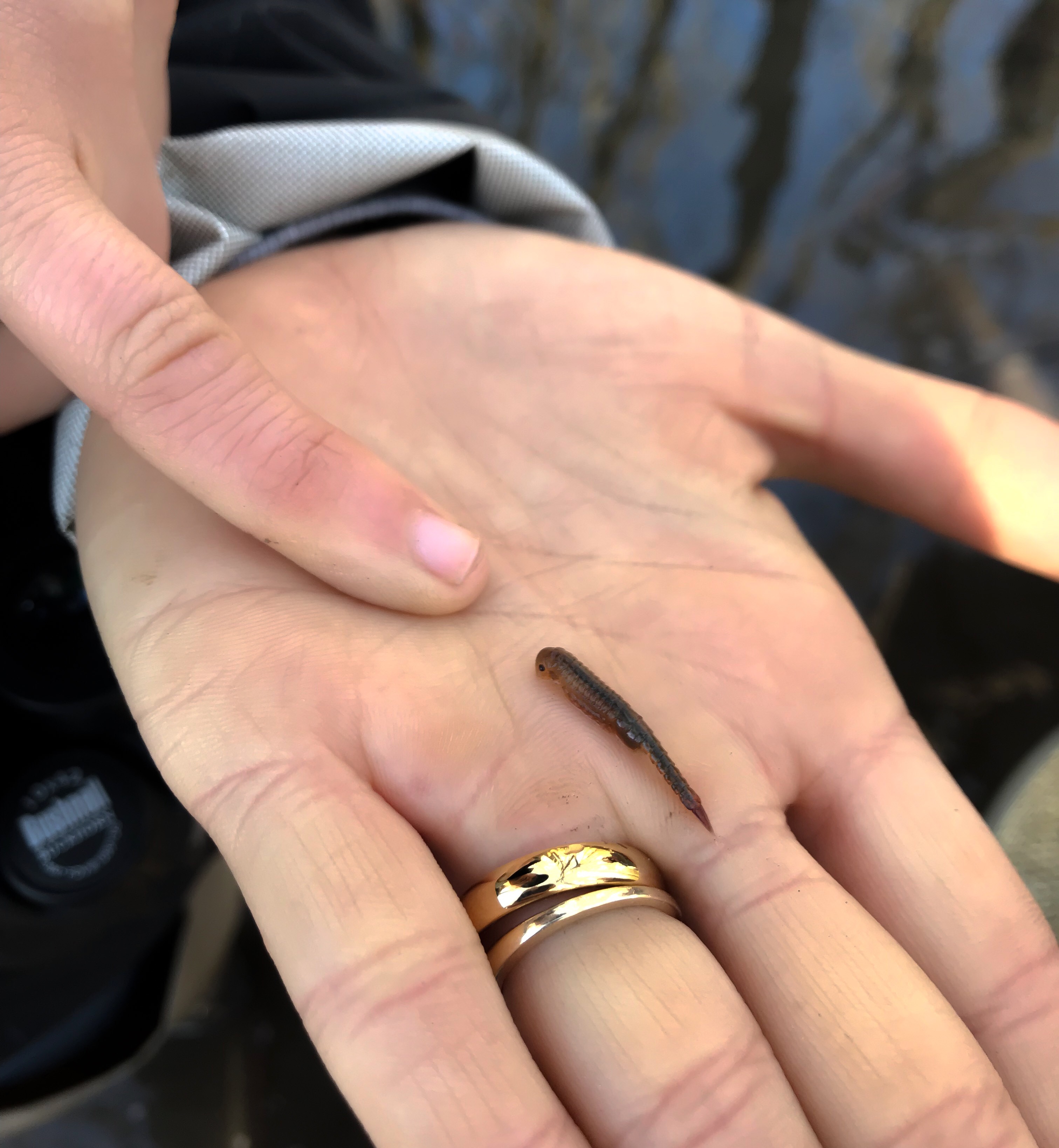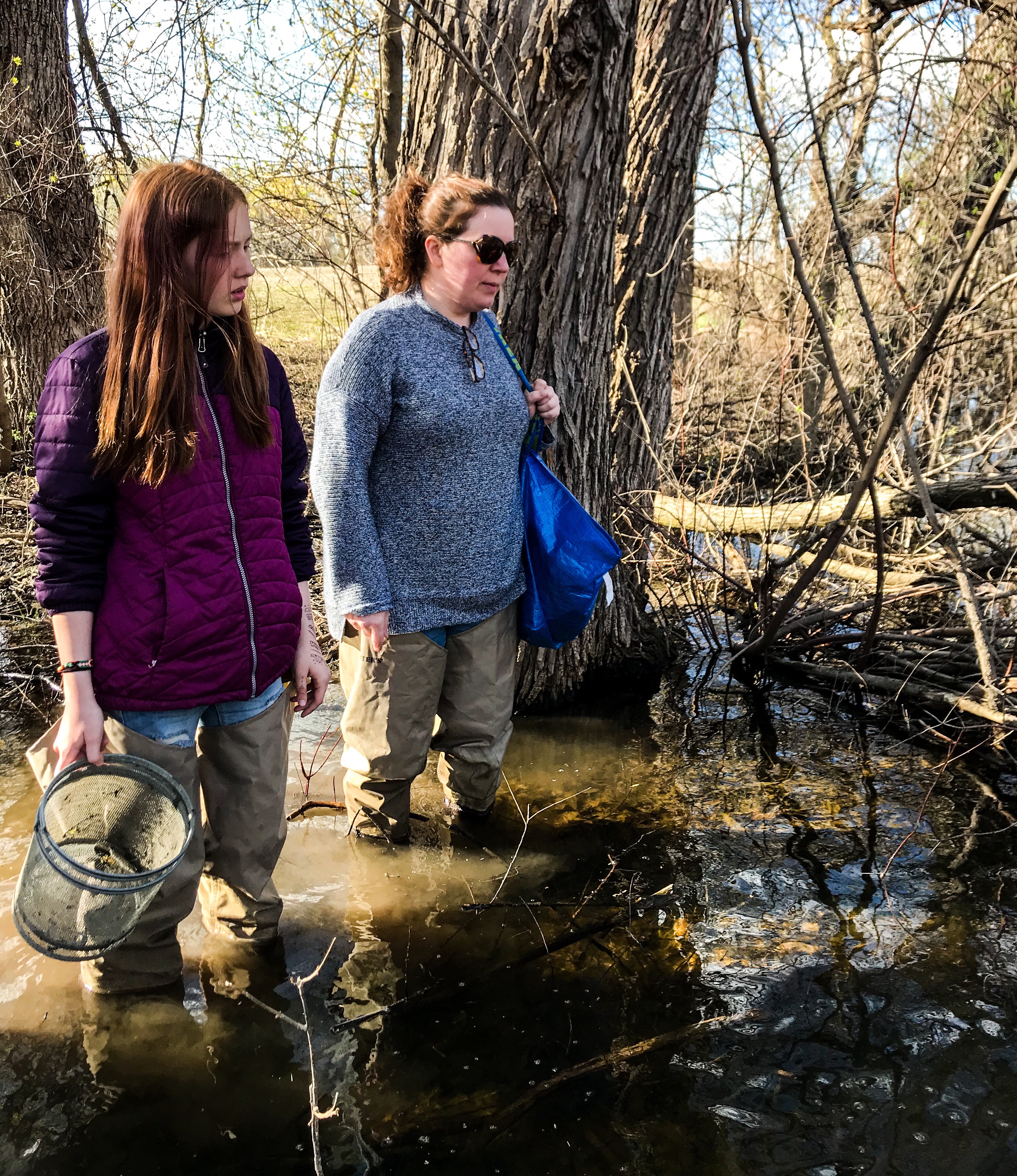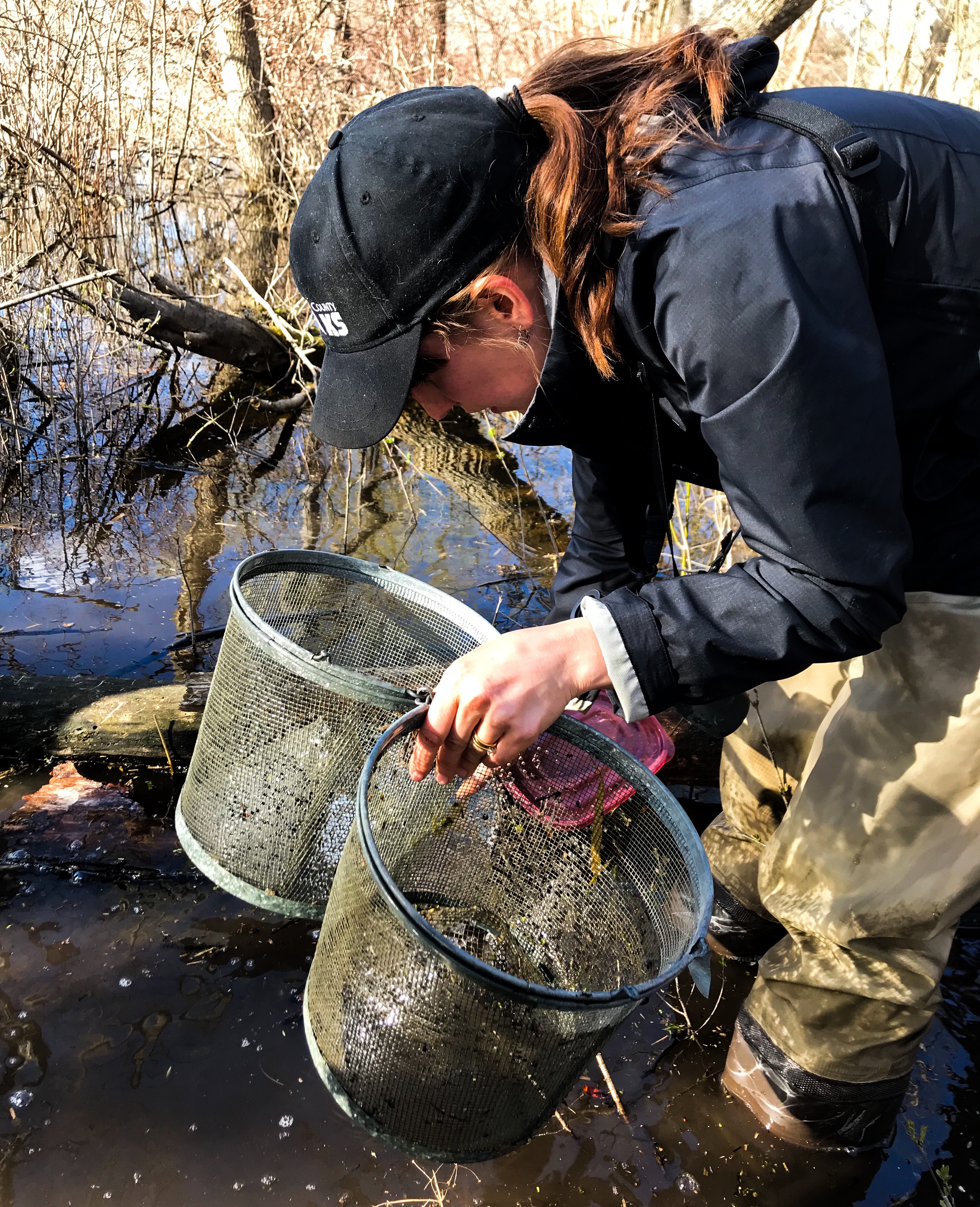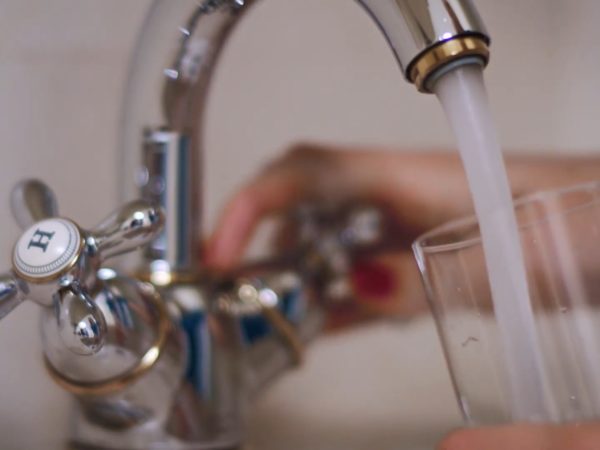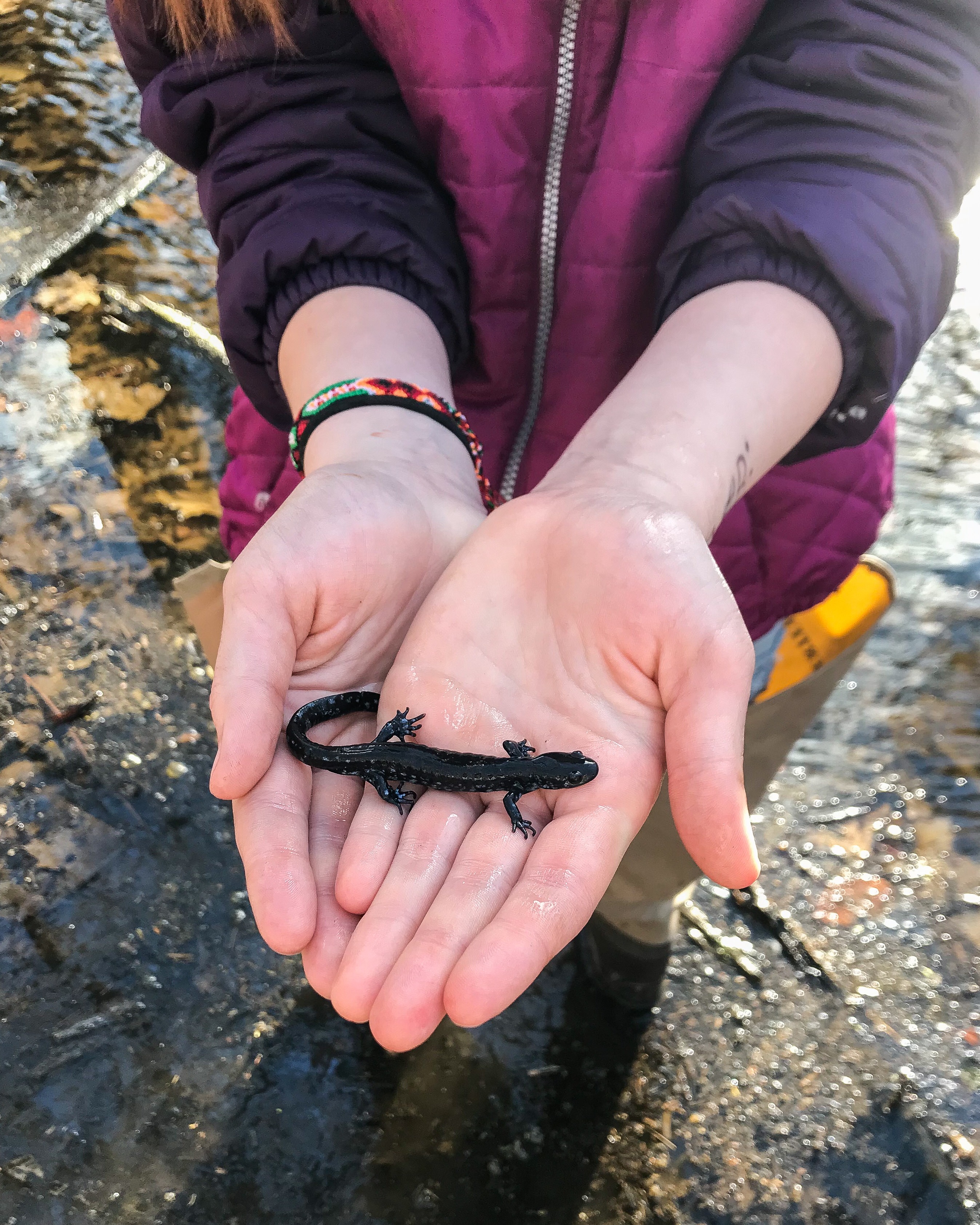
Read part one here.
The pond hidden on one side of an old soybean field in Barloga Woods is anything but quiet.
Chorus frogs produce a cacophony of rippling croaks. Birds call out. Traffic hums as cars and motorcycles stream down the road toward IKEA, the first of this furniture chain built in Wisconsin.
On one sunny April day, amidst the natural and engine-generated din, came the crunch of booted feet marching over dried twigs and leaves, then the watery burble of those same feet wading into the pond.
“Want to see this algae?” called out 13-year-old Aria Hayden as she pushed through the knee-deep water toward one of the traps she set with her mother a day earlier. “Guess you could say we’re in a bit of a … sticky situation.”
The pun elicited chuckles from Aria’s mother, Erica Hayden, and Emilie Burmeister, the assistant natural areas coordinator for Milwaukee County Parks. It was a sunny day with a light breeze, and no one seemed bothered by the chill water pressing against their waders as they stepped toward the first wire trap.
The funnel-shaped contraption hung from a low tree, half-immersed in pond water. As Aria opened it, Erica pulled out a sheet of paper so she could record the species they found inside.
“There’s a little fish in there!” Aria announced excitedly. “There’s the fish and there’s a bunch of snails.”
Burmeister traipsed over to look at the wriggling creature, gently cupping it in her hand. It was smaller than a hairpin, with a tiny black eye, and its sides inflated ever so slightly as she watched.
Not a fish, Burmeister clarified, it was a type of fairy shrimp, a macroinvertebrate that may eventually serve as a tasty meal for larger creatures like salamanders.
Erica recorded the name of the creature in her chart, then she and Aria emptied the trap and closed it back up.
Erica and Aria are both volunteers for the Milwaukee Wetland Monitoring program, a citizen-science effort aimed at documenting some portion of the 400 ephemeral wetlands that still exist in Milwaukee County. Most of these little ponds are tiny bodies of water that dry up in the summer and that you might never notice unless you were looking for them.
But with the help of volunteers, plenty of people now have their eyes trained on the ponds, and their data is helping guide conservation and development decisions. In 2016 the program even won an award from the Department of Natural Resources.
The pond the mother-daughter duo have been charged with surveying this spring happens to be located in a residential area. They’ve had a handful of conversations with curious neighbors who want to know why these two women are tromping around in waders with a collection of traps. Those conversations often result in a burst of curiosity about the city’s native ecosystems, and that’s sort of the point. People—scientists and citizens—need to know what’s in the wetlands in order to protect them.
People can coexist with wildlife, if we plan for it
“Wetlands are definitely in crisis,” said environmental scientist Gary Casper, whose work helped create the very surveying methods now employed by volunteers. “Regulations have slid backwards in the past 10 years.”
Recently, deregulation in Wisconsin has included a 2018 bill allowing some wetlands in urban areas to be filled without permits. It was a controversial decision, with those on the side of industry and development arguing in its favor, and those who work on protecting the environment pushing against it.
In Milwaukee, the parks department encompasses 75 percent of the city’s remaining green space, so most of the remaining wetlands are safe.
But sometimes compromises must be made. In 2017, IKEA purchased an empty lot that held one of the city’s ephemeral wetlands, a pond in which volunteers had counted a number of salamanders.
There was no fighting it, Burmeister said, so instead the parks department used the data they’d collected to partner with the company. They gained a bit of forested land nearby, and parks employees collected every salamander from the property and relocated them to this new pond.
IKEA then paid to build a long wooden fence dividing the pond from their building site. Five feet above ground and three feet below, the wetland exclusion barrier is, in essence, a way to protect salamanders from their own instincts. The little amphibians always return to the same place to breed. With a fence in their way, they’re forced to stay in their new home.
“People can coexist with wildlife. It’s really up to us to decide how much biodiversity is in our backyard,” Casper said. “It doesn’t happen by itself. You have to plan for it.”
Volunteer program has ‘direct positive impact’ on wildlife
A full 75 percent of all animal species in Wisconsin rely on wetlands at some point in their life cycle, according to Burmeister. Understanding how those animals function in their environment helps scientists and land managers make the best possible decisions when it comes to protecting their habitat. Without the help of volunteers like Aria and Erica, collecting so much data would be almost impossible.
For Erica, who grew up on a farm and fell in love with the city because of its parks, volunteering in the wetland monitoring program is a much-appreciated opportunity to get outside. For Aria, it’s continued her growing love for wildlife.
After working in her schools aquaponic greenhouse, she decided she wanted to be a conservation biologist, and this experience has only stoked that ambition. She’s terrified of bugs and initially worried that running across beetles and other creepy crawlies would be too much. But now she’s not so bothered by them, and she didn’t even mind coming out to check the pond when it was still rimmed with ice in early April.
“The first time we went to a pond [for volunteer training], I fell into the mud and was just covered,” Aria said. “That was my first experience, and I still wanted to do it.”
Burmeister agreed that working outdoors comes with its share of difficulties. She once came back from the field covered in 22 ticks. One of her colleagues has been treated for Lyme disease twice.
But to her, there’s no better job in the world. Counting snakes and owls and frogs and salamanders, teaching volunteers how to do surveys, seeing how much everyone loves being involved in the program, knowing the work will have a direct positive impact on the wildlife — it’s gratifying even when it’s messy, she said.
Aria and Erica would gladly continue volunteering for the program in the future, but Burmeister suspects the parks department will have to end it after another year or so. Not only have they collected reams of data, but they also don’t want to keep disturbing the wildlife. However good their intentions, these wetlands are still relatively fragile ecosystems.
The data that’s already been collected is incredibly valuable. Knowing where certain species are thriving will help the city make future land management decisions and understand how best to clean up degraded habitats. If not for data collected by scientists and citizens, it’s likely no one would have known that the IKEA was being built on an area populated by salamanders. And without volunteers, the parks department wouldn’t have the capacity to monitor so many different areas.
Before the group packed up and left, Burmeister lead them to a different pond where she found a blue-spotted salamander, the most common species in the area. Burmeister retrieved it from the trap, and Aria dampened her hands so that the amphibian would be more comfortable. The shiny, black creature squiggled around her palm and tried to burrow between her fingers.
“What a cutie,” Aria said.
Burmeister agreed. “They’ve got four little fingers in the front and five toes in the back. People say baby toes are cute, and I’m like, you haven’t seen a salamander.”
That kind of wildlife presence and biodiversity is what Milwaukee County Parks is trying to maintain with Barloga Woods.
It’s also what the city of Milwaukee is eventually hoping to achieve with the Grand Trunk/Bay View wetlands restoration project, an initiative aimed at revitalizing Milwaukee’s wetlands.


